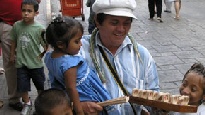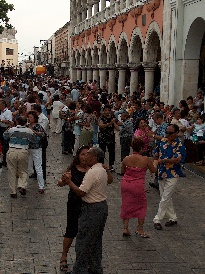 |
|
|
OSEA Field School, MIRA Project 2005 Student Testimony: Jenna's Experience
"My fourth day in Mérida, while walking the streets of El Centro Histórico (the historic center), I was exposed to the Maya language for the first time, by the last person I might have expected to speak to me in anything other than Spanish or English. My wanderings in the city were usually confined to the portion of Calle 60 (60th Street) that runs between the Plaza Principal (Plaza Grande, the center of town) and Parque de Santa Lucía (Santa Lucia Park), where the majority of tourist activity takes place and the presence of vendors and artesanías shops is greatest. This particular Wednesday night as I meandered along El Callejón del Congreso, the pedestrian walkway that connects Calle 60 and Calle 58 (58th Street), a cigar vendor named René who had attempted to sell Cuban cigars to me on several occasions, approached me and asked me how his outfit looked. I smiled and told him he looked "muy guapo" [very handsome]; his collared long-sleeve navy blue shirt with white dotted pin-stripes appeared to be a new addition to his wardrobe, his business-like attire quite appropriate for the classy cigar-smoking crowd he was trying to appeal to. René beamed in response to my comment, his small eyes dancing as his round face creased in smile. He asked if he might borrow the notebook I was holding to write down some Maya that he wanted to teach me. Standing beneath the trees that border Parque de la Madre (The Motherhood Park), I was not sure if I felt prepared for a language lesson, but I willingly handed over my field notebook and watched as he painstakingly scrawled out the first phrase and its Spanish translation in all capital letters: BIZHAKABÁH. COMO TE LLAMAS. He pronounced the words and gave me a chance to repeat them, nodding in patient approval as Maya reverberated from the depths of my vocal chords for the first time. As my lesson continued, I realized that René was sharing a part of himself with me; he was revealing a layer of his identity that he wanted me to know was important to him. BAXCAHUAY. QUE DICES. He said his mind was far too "duro" [hard, dense] to learn English but that it was good for me to learn Maya while my mind was sharp. TUXX A TAAL. DE DONDE BIENES. I was to practice and he would see what I remembered the next day, "Es muy difícil la Maya" [Maya is difficult], he warned me. BAX KAÁ TU QUI?. EN QUE PIENSAS. As we parted ways, I knew I had just caught a glimpse of the "mysterious Maya" that I was looking for; there before my eyes had stood a vendor who expressed himself in Maya, who was not the indigenous character I had envisioned, but nonetheless had a very real sense of identity wrapped up in the culture." I learned from René that "Mayaness" is not necessarily packaged
in a certain appearance, but that as an expression of identity, it
can take a variety of forms...My encounter with René allowed me to
discover a "Mayaness" typical to Mérida, where behind the modern Yucatec
façade of a civilized-colonial city, a connection to the indigenous
roots of Maya culture screams for recognition. In accordance with
the dress-code of modernity, René manicures his appearance, becoming
who the tourists want to see when they buy a Cuban cigar to enjoy
after dinner. However, enmeshed with this vendor personality, though
not as visible, thrives an equally strong Maya identity, waiting to
broadcast itself to anyone who lends an ear to listen. Regarding the
Maya, René put it eloquently when he told me, "somos un tesoro guardado"
[we are a hidden treasure]; I only hoped I would be able catch a glimpse
of the jewels he described.
|





